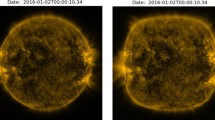Abstract
In this paper, we introduce two novel models for processing real-life satellite images to quantify and then visualise their magnetic structures in 3D. We believe this multidisciplinary work is a real convergence between image processing, 3D visualisation and solar physics. The first model aims to calculate the value of the magnetic complexity in active regions and the solar disk. A series of experiments are carried out using this model and a relationship has been indentified between the calculated magnetic complexity values and solar flare events. The second model aims to visualise the calculated magnetic complexities in 3D colour maps in order to identify the locations of eruptive regions on the Sun. Both models demonstrate promising results and they can be potentially used in the fields of solar imaging, space weather and solar flare prediction and forecasting.
Similar content being viewed by others
Abbreviations
- MDI:
-
Michelson Doppler Imager
- SOHO:
-
Solar and Heliospheric Observatory
- ESA:
-
European Space Agency
- NASA:
-
National Aeronautics and Space Administration
- NGDC:
-
National Geophysical Data Center
- GIF:
-
Graphic Interchange Format
- NOAA:
-
National Oceanic and Atmospheric Administration
- OpenGL:
-
Open Graphics Library
- ASAP:
-
Automated Solar Activity Prediction
References
Moldwin, M.: An Introduction to Space Weather. Cambridge University Press, Cambridge (2008)
O.o.t.F.C.f. Meteorology: National space weather program strategic plan (1995)
Koskinen, H., Tanskanen, E., Pirjola, R., Pulkkinen, A.: Space weather effects catalogue. In: ESA Space Weather Study (ESWS), January 2, 2001
N.R.C. Committee on the societal and economic impacts of severe space weather events: A workshop. In: Severe Space Weather Events–Understanding Societal and Economic Impacts: A Workshop Report. The National Academies Press, Washington (2008)
Halloween storm surge shocks earth. Space Today 2008 (2004) (Online)
Qahwaji, R., Colak, T.: Automatic prediction of solar flares using machine learning: practical study on the Halloween storm. In: IEEE Conference on Recent Advances in Space Technologies, Istanbul. IEEE Press, New York (2007)
Feynman, J., Gabriel, S.B.: On space weather consequences and predictions. J. Geophys. Res. 105, 10543–10564 (2000)
Pick, M., Lathuillere, C., Lilensten, J.: Ground based measurements. In: ESA Space Weather Programme Feasibility Studies (2001)
Lenz, D.: Understanding and predicting space weather. Ind. Phys. 18–21 (2004)
Dispatch, S.T.: Internet space weather and radio propagation forecast course. In: Solar Terrestrial Dispatch, 1996–2001
Scherrer, P.H., Bogart, R.S., Bush, R.I., Hoeksema, J.T., Kosovichev, A.G., Schou, J., Rosenberg, W., Springer, L., Tarbell, T.D., Title, A., Wolfson, C.J., Zayer, I., Team, T.M.E.: The solar oscillations investigation—Michelson Doppler imager. Sol. Phys. 162, 129–188 (1995)
Ising, E.: Beitrag zur Theorie des Ferromagnetismus. Z. Phys. 31, 3–4 (1925)
Ahmed, O., Qahwaji, R., Colak, T., Dudok De Wit, T., Ipson, S.: A new method for processing solar images to calculate the magnetic energies associated with active regions. In: 5th International Multi-Conference on Systems, Signals and Devices, 2008. IEEE SSD 2008, pp. 1–5 (2008)
Ahmed, O., Qahwaji, R., Colak, T., Dudok De Wit, T., Ipson, S.: Applying a modified Ising algorithm to calculate the energy of solar active regions in solar images. In: Mosharaka International Conference on Communications, Computers and Applications, 2008. MIC-CCA 2008, pp. 43–48. Amman (2008)
Tracking the movement of sunspots. Science NetLinks
Lang, K.R.: Sun, Earth and Sky. Springer, Berlin (1995)
Sethna, J.P.: Statistical Mechanics: Entropy, Order Parameters, and Complexity. Oxford University Press, Oxford (2007)
Rowe, G.W., Le, T.: A thermodynamic theory of codon bias in viral genes. J. Theor. Biol. 101, 171–203 (1983)
Irbäck, A., Peterson, C., Potthast, F.: Evidence for nonrandom hydrophobicity structures in protein chains. Proc. Natl. Acad. Sci. USA 93, 9533–9538 (1996)
Ahsan, A., Rudnick, J., Bruinsma, R.: Elasticity theory of the B-DNA to S-DNA transition. Biophys. J. 74, 132–137 (1998)
Wierzchon, S.T.: Ising model, E.W. Weisstein (ed.) Wolfram Research, 1996–2007
Knoll, M.J., Leka, K.D., Barnes, G.: Statistical prediction of solar flares using line of sight magnetogram data, 31 July 2008
Colak, T., Qahwaji, R.: Automated McIntosh-based classification of sunspot groups using MDI images. Sol. Phys. 248, 277–296 (2008)
Gonzalez, R.C., Woods, R.E.: Digital Image Processing. Prentice Hall, New York (1982)
Colak, R.Q.T.: ASAP: a hybrid computer platform using machine learning and solar imaging for automated prediction of significant solar flares. Space Weather (2008)
Qahwaji, T.C.R.: Automatic detection and verification of solar features. Int. J. Imaging Syst. Technol. 15, 199–210 (2005)
Author information
Authors and Affiliations
Corresponding author
Additional information
Original work presented in CyberWorlds 2009 Conference.
Rights and permissions
About this article
Cite this article
Ahmed, O.W., Qahwaji, R., Colak, T. et al. A new technique for the calculation and 3D visualisation of magnetic complexities on solar satellite images. Vis Comput 26, 385–395 (2010). https://doi.org/10.1007/s00371-010-0418-1
Published:
Issue Date:
DOI: https://doi.org/10.1007/s00371-010-0418-1




